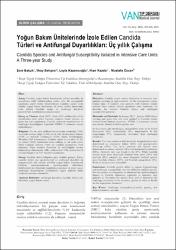Yoğun bakım ünitelerinde izole edilen candida türleri ve antifungal duyarlılıkları: Üç yıllık çalışma
Citation
Batcik, S., Bahceci, I., Kazancioglu, L., Kazdal, H. & Ozcan, M. (2021). Yoğun Bakım Ünitelerinde İzole Edilen Candida Türleri ve Antifungal Duyarlılıkları: Üç yıllık Çalışma. Van Tıp Dergisi, 28(3), 459-465.Abstract
Amaç: Candida, yoğun bakım hastalarında yüksek mortalite ile
sonuçlanan ciddi enfeksiyonlara neden olur. Bu retrospektif
çalışmada çeşitli klinik örneklerinden Candida suşları izole
edilmiş yoğun bakım hastalarına ait klinik veriler incelenmiş;
izole edilmiş Candida suşları ve antifungal duyarlılık
paternlerinin tanımlanması amaçlanmıştır.
Gereç ve Yöntem: Ocak 2017– Ocak 2020 tarihlerinde; klinik
örneklerden izole edilen Candida suşlarına Gram boyama ve
germ tüp testi uygulanmış, Candida türlerinin tanımlanması ve
antifungal duyarlılığının tespitinde VITEK 2 otomatize sistem
kullanılmıştır.
Bulgular: En sık yatış endikasyonu solunum yetmezliği (%66)
ve cerrahi sonrası takip (% 14); en sık risk faktörü üriner kateter
(%94) ve mekanik ventilasyon (%84) olarak belirlenmiştir.
Mortalite %60 bulunmuştur. Candida suşları en sık idrar (% 59)
ve trakeal (%22) örneklerden izole edilmiş; en sık izole edilen
türler Candida albicans (%83) ve Candida parapsilosis (%4)
olmuştur. Tüm izolatlar flusitozin ve mikafungine duyarlı
bulunurken, flukonazole %88, vorikonazole %96, amfoterisin B
ve kapsofungine ise %97 duyarlı bulunmuştur.
Sonuç: Candida türleri bölgelere göre farklılık gösterir. Farklı
candida türleri için epidemiyoloji ve antifungal duyarlılık da
değişmektedir. Bu sebeple özellikle yoğun bakım hastalarında
Candida enfeksiyonlarında epidemiyolojik faktörlerin
belirlenmesi tür düzeyinde tanımlama yapılması ve etken suşun
antifungal duyarlılığının belirlenmesi uygun tedaviye karar
verilmesi açısından önemlidir.. Objective: Candida causes serious infections in intensive care
patients resulting in high mortality. In this retrospective study,
clinical data of intensive care patients with Candida strains
isolated from various clinical specimens were examined; To
describe the isolated Candida strains and antifungal
susceptibility patterns .
Materials and Methods: In January 2017 - January 2020; Gram
staining and germ tube test were applied to Candida strains
isolated from clinical specimens. VITEK 2 automated system
was used to identify Candida species and
to flucytosine and micafungin, susceptibility were to be found
fluconazole 88%, voriconazole 96%, amphotericin B and
caspofungin 97%, respectively. determine their antifungal
sensitivity.
Results: The most common indications for hospitalization were
determined as respiratory failure (66%) and postoperative
follow-up (14%). The most common risk factors were
determined as urinary catheter (94%) and mechanical ventilation
(84%). Mortality rate was found to be 60%. While Candida
species were most frequently isolated from urine (59%) and
tracheal (22%) samples, the most frequently isolated species
were Candida albicans (83%) and Candida parapsilosis (4%).
While all isolates were susceptible
Conclusion: Candida species differ by region. Epidemiology
and antifungal susceptibility vary for different candida species.
For this reason, it is important to determine the epidemiological
factors in Candida infections, especially in intensive care
patients, to determine the species level, and to determine the
antifungal sensitivity of the causative species in order to decide
on the appropriate treatment.
Source
Van Tıp DergisiVolume
28Issue
3URI
https://search.trdizin.gov.tr/tr/yayin/detay/1127395/yogun-bakim-unitelerinde-izole-edilen-candida-turleri-ve-antifungal-duyarliliklari-uc-yillik-calismahttps://hdl.handle.net/11436/7461


















